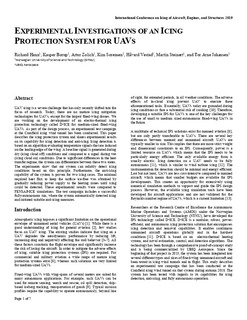| dc.contributor.author | Hann, Richard | |
| dc.contributor.author | Borup, Kasper Trolle | |
| dc.contributor.author | Zolich, Artur Piotr | |
| dc.contributor.author | Sørensen, Kim Lynge | |
| dc.contributor.author | Vestad, Håvard Nitter | |
| dc.contributor.author | Steinert, Martin | |
| dc.contributor.author | Johansen, Tor Arne | |
| dc.date.accessioned | 2019-11-27T09:23:48Z | |
| dc.date.available | 2019-11-27T09:23:48Z | |
| dc.date.created | 2019-07-15T09:35:19Z | |
| dc.date.issued | 2019 | |
| dc.identifier.citation | SAE technical paper series. 2019, 2019-June (June), . | nb_NO |
| dc.identifier.issn | 0148-7191 | |
| dc.identifier.uri | http://hdl.handle.net/11250/2630692 | |
| dc.description.abstract | UAV icing is a severe challenge that has only recently shifted into the focus of research. Today, there are no mature icing mitigation technologies for UAVs, except for the largest fixed-wing drones. We are working on the development of an electro-thermal icing protection technology called D•ICE for medium-sized fixed-wing UAVs. As part of the design process, an experimental test campaign at the Cranfield icing wind tunnel has been conducted. This paper describes the icing protection system and shares experimental results on its capability for icing detection and anti-icing. Icing detection is based on an algorithm evaluating temperature signals that are induced on the leading-edge of the wing. A baseline signal is generated during dry (icing cloud off) conditions and compared to a signal during wet (icing cloud on) conditions. Due to significant differences in the heat transfer regime, the system can differentiate between these two states. The experiments show that our system can reliably detect icing conditions based on this principle. Furthermore, the anti-icing capability of the system is proven for two icing cases. The minimal required heat flux to keep the surface ice-free was obtained by gradually reducing power supply to the heating zones until icing could be detected. These experimental results were compared to FENSAP-ICE simulations. The test campaign includes a successful fully-autonomous run, where the system automatically detected icing and initiated suitable anti-icing measures. | nb_NO |
| dc.language.iso | eng | nb_NO |
| dc.publisher | SAE International | nb_NO |
| dc.title | Experimental Investigations of an Icing Protection System for UAVs | nb_NO |
| dc.type | Journal article | nb_NO |
| dc.type | Peer reviewed | nb_NO |
| dc.description.version | acceptedVersion | nb_NO |
| dc.source.pagenumber | 5 | nb_NO |
| dc.source.volume | 2019-June | nb_NO |
| dc.source.journal | SAE technical paper series | nb_NO |
| dc.source.issue | June | nb_NO |
| dc.identifier.doi | 10.4271/2019-01-2038 | |
| dc.identifier.cristin | 1711446 | |
| dc.relation.project | Regionale forskningsfond Midt-Norge: 285248 | nb_NO |
| dc.relation.project | Norges forskningsråd: 284649 | nb_NO |
| dc.relation.project | Notur/NorStore: NN9613K | nb_NO |
| dc.relation.project | Norges forskningsråd: 223254 | nb_NO |
| dc.relation.project | Norges forskningsråd: 237906 | nb_NO |
| dc.description.localcode | © 2019. This is the authors’ accepted and refereed manuscript to the article. Locked until 10.12.2019 due to copyright restrictions. | nb_NO |
| cristin.unitcode | 194,63,25,0 | |
| cristin.unitcode | 194,64,92,0 | |
| cristin.unitname | Institutt for teknisk kybernetikk | |
| cristin.unitname | Institutt for maskinteknikk og produksjon | |
| cristin.ispublished | true | |
| cristin.fulltext | postprint | |
| cristin.qualitycode | 1 | |
